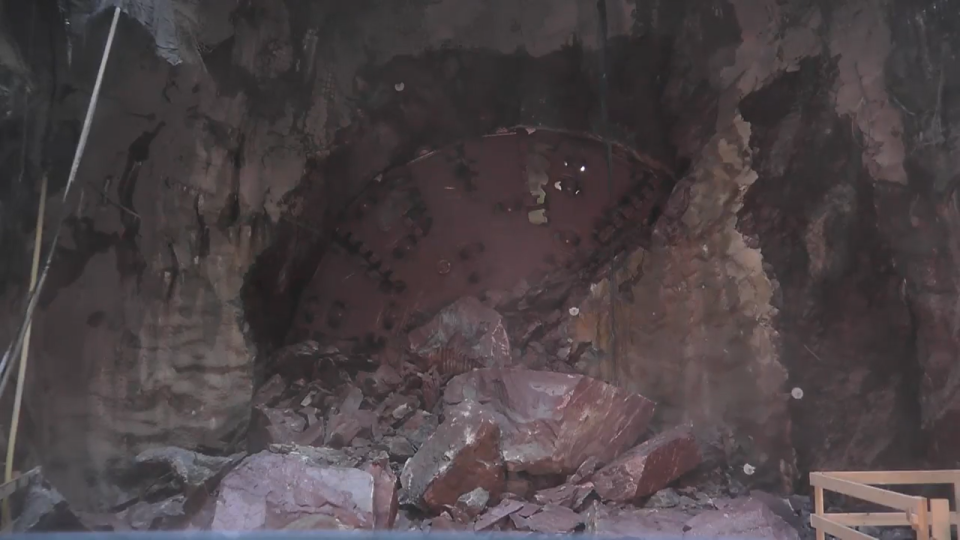Drilling of a 2.2-mile sewer tunnel under Rhode Island is finally complete. What comes next?
PAWTUCKET – In a huge burrow deep beneath the east bank of the Seekonk River on Thursday morning, heavy blocks of stone came crashing down as a giant machine chewed through the last stretch of bedrock to complete a 2.2-mile-long tunnel aimed at keeping the waters of Narragansett Bay clean.
With its cutter head rotating relentlessly, the tunnel boring machine has been working around the clock for a year and a half, grinding through 25 millimeters of rock face each minute to carve out the 30-foot diameter tunnel that will capture stormwater and sewage before they can reach the Seekonk River and then the Bay.
The work has been painstaking and incremental, but in the end it wrapped up sooner than anticipated.
“They were a little bit ahead of where we thought they would be,” said Jamie Samons, spokeswoman for the Narragansett Bay Commission, operator of the biggest wastewater treatment system in Rhode Island.
What will the tunnel do?
The 125-foot-deep tunnel is the centerpiece of the final phase of the commission’s decades-long, $1.7-billion project to prevent combined sewer overflows from polluting New England’s largest estuary.
Runoff from rains, especially when mixed with household waste, is one of the leading threats to the body of water at the heart of Rhode Island. The runoff transports the bacteria that close beaches and shellfish beds, as well as nutrients that cause dangerous algae blooms.
![When it's complete, the 2.2-mile tunnel along the east bank of the Seekonk River in Pawtucket will be able to store the equivalent of 92 Olympic-sized swimming pools of wastewater overflow during storms. [Kris Craig/The Providence Journal, file]](https://s.yimg.com/ny/api/res/1.2/brmlxTOWuOIQBvBeuEy38g--/YXBwaWQ9aGlnaGxhbmRlcjt3PTk2MDtoPTE0NDA-/https://media.zenfs.com/en/the-providence-journal/92f7e8ea768c04297fa7124596ecf3f1)
So, during the biggest storms, when the commission’s wastewater pipes are overloaded with rainfall rushing from roofs, sidewalks and streets into drains, the excess stormwater mixed with effluent will be channeled into storage tunnels instead of being discharged untreated. When the storm clouds part, the mixture is pumped back to the surface, treated and finally released into the rivers that empty into the Bay.
More: Giant RI sewer project is cleaning Narragansett Bay. But is it too costly for ratepayers?
The first two phases of the project wrapped up in Providence nearly a decade ago. They included a 26-foot diameter, 3-mile tunnel that begins beneath downtown and follows the Providence River to the commission’s treatment plant at Fields Point.
The new tunnel that is at the heart of Phase III runs from the vicinity of the commission’s other treatment plant at Bucklin Point in East Providence into Pawtucket along the east bank of the Seekonk River. It will be able to store 58.5 million gallons of overflow.
All told, the entire project aims to take care of 98% of overflow volumes into the Bay. The work so far in Providence has resulted in drastically lower bacteria counts, clearer water and reduced numbers of shellfish bed closures.

Work on the CSO project is far from over
While the completion of the tunnel marks a major milestone for the construction project, there is still much work to be done.
First things first, the 300-foot-long boring machine will have to be disassembled and lifted back to the surface.
Then, work will pick up on the four drop shafts that will channel overflows into the storage tunnel.
And finally, the pump station that will send the stored mix of dirty water to the Bucklin Point plant for treatment will be completed.
The project is on schedule and set to wrap up in 2026.
“We are excited to complete this important milestone in the Phase III RestoredWaters RI project,” said commission chairman Vincent Mesolella. “We are continuing to see the positive results of the investments made through this project, including a significantly cleaner Narragansett Bay, reopening of shellfishing beds and healthier waters for all Rhode Islanders for generations to come.”
This article originally appeared on The Providence Journal: Drilling of sewer overflow tunnel under Pawtucket is finished.
